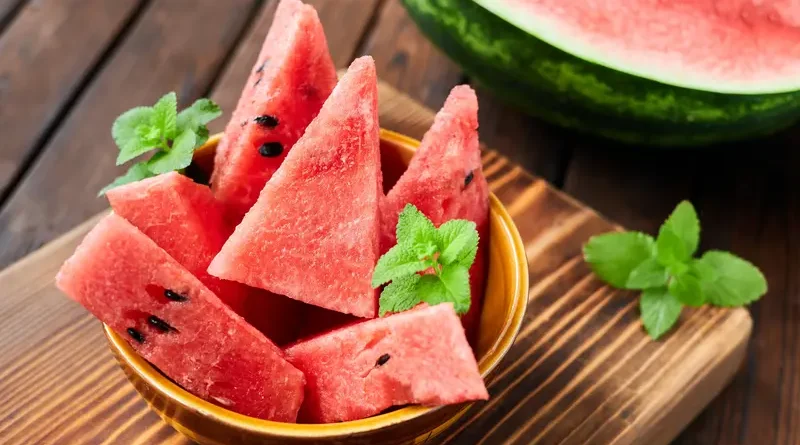Discover the Juicy World of Watermelon
This is the luscious world of watermelon, welcome! One of the most popular summer fruits, watermelons are a sign of happiness in the summertime as well as a cool delight on hot days. Watermelons are native to Africa and have spread over the world, satisfying palates and providing nourishment to bodies with their juicy, sweet flesh.
We invite you to discover the many facets and marvels of this well-known fruit as we delve into its intriguing many kinds, nutritional advantages, production methods, culinary applications, and much more in this piece. Therefore, take a bite, relax, and explore the cool world of watermelons.
Botanical Characteristics and Varieties of Watermelon
The Cucurbitaceae family includes watermelon (Citrullus lanatus), which is distinguished by its luscious flesh, thick rind, and seeds. Based on seed characteristics, watermelon varieties can be roughly classified into three types: seeded, seedless, and tiny. Traditional seeds are found in watermelons with seeds, whereas watermelons without seeds have tiny, immature seeds or none at all.
Smaller-sized fruits that are bred for individual eating are called miniature watermelons. Because each variety has its distinct flavors, colors, and textures. Watermelon is a fruit that is widely used in culinary traditions around the world.
Nutritional Composition and Health Benefits of Watermelon
In addition to being a delightful summertime treat, also has several health advantages and is a great source of important nutrients. Its high water content helps you stay hydrated. And it also contains potassium, vitamins A and C, and antioxidants like lycopene.
These nutrients help maintain heart, skin, and immune system health, and the fruit’s low-calorie count makes it a snack that is good for weight loss. Its fiber content facilitates digestion, and its antioxidants may help lower the chance of developing certain illnesses. Including watermelon in your diet can be a hydrating and nourishing option for your general health.
Growing Watermelons: Cultivation Techniques and Environmental Requirements
To guarantee ideal development and fruit yield, watermelon agriculture necessitates careful consideration of particular environmental factors and cultivation practices. Good soil and climate selection, site preparation, planting, irrigation, fertilization, weed control, and insect management are important factors to take into account.
A great harvest depends on proper care given during the growing season. Which includes keeping an eye out for pests and diseases, encouraging pollination, and giving plants enough support. Growers can maximize yields and produce high-quality fruit for retail or local markets by adhering to best practices for watermelon farming.
Harvesting, Storing, and Handling Watermelons
Watermelons have their best flavor and texture when harvested when they are at their prime. When watermelons are ripe, they have a creamy yellow center. A dry tendril close to the stem, and a dull sound when tapped. To preserve freshness, store picked watermelons in a cool, dry location, ideally between 50°F and 60°F.
Take extra care while handling them to avoid cuts or bruises, and support them from below when in transit. Watermelons have a longer shelf life when handled and stored properly, so you may savor their delightful flavor for longer.
Culinary Uses of Watermelon in Various Cuisines
Beyond just being a refreshing fruit, watermelon is a culinary chameleon that can be used in a variety of cuisines around the world. Here are some ways that watermelon entices the senses, both sweet and savory:
Fresh Consumption:
Watermelon, whether sliced or cubed, is a summertime favorite. It may be enjoyed as a light snack or dessert, and it tastes great when seasoned with lime juice, salt, or chili powder.
Salads and Salsas:
Watermelon balances savory or spicy elements in salads and salsas by adding sweetness and juiciness. For a flavorful kick, try it with cucumber, jalapeños, or feta.
Beverages:
It provides a refreshing base for beverages, combining nicely with various fruits and herbs. Whether it is used for freshly squeezed juice, blended smoothies, or blended cocktails.
Frozen Treats:
Watermelon pieces can be frozen for a guilt-free snack or blended into sorbets and popsicles for a refreshing summertime treat.
Soups and Gazpachos:
A cool first course is chilled watermelon soup, or gazpacho. Which is made by pureeing watermelon and adding tomatoes, cucumbers, and herbs for a tasty twist.
Desserts:
Watermelon can be used as a natural bowl for fruit salads, sorbets, or parfaits. Giving a whimsical touch to the presentation, or it can be included in cakes, tarts, or puddings for a fruity finish.
Watermelon in Traditional Medicine and Folklore
In many countries’ traditional medical practices and mythology, it has a special role. In Ayurveda and traditional Chinese medicine, it is highly valued for its cooling qualities, which are used to balance internal heat and treat heat-related illnesses. Furthermore, its seeds are thought to have sexual qualities in some cultures and are frequently used in traditional cures for digestive problems.
Aside from its therapeutic use, watermelon is rich in ritual and symbolism. In African mythology and folklore, it is frequently connected to fertility, wealth, and good fortune. In addition to its cool flavor, watermelon has long been valued for its therapeutic qualities and cultural importance.
Conclusion
In summary, watermelon is more than simply a tasty summer fruit; it is also a symbol of energy and enthusiasm with a rich cultural heritage that crosses national boundaries. It is a cherished mainstay in cuisines all over the world because of its many variants, nutritional advantages, and culinary adaptability.
From its African beginnings to its global travels, watermelon has captivated palates and satisfied bodies, providing customers who are health-conscious with a pleasant and nourishing option. Watermelon is a luscious fruit that embodies summertime delight and can be relished fresh, in salads, drinks, or even as a medicinal cure.
Its juicy universe welcomes exploration and enjoyment. So enjoy a slice, accept its sweetness, and immerse yourself in the cool paradise that is watermelon.
You Can Read More About Watermelon
Is it ok to Eat Watermelon on a Low Carb Diet? A Complete Guide
